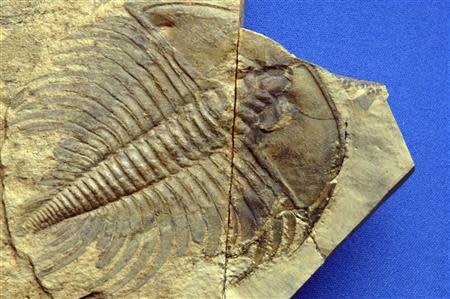Methane-spewing microbe blamed in Earth's worst mass extinctionReuters
By Will Dunham March 31, 2014 4:00 PM
 A fossil of a trilobite, a horsecrab-like creature that thrived in the seas for hundreds of millions of years before becoming one of many kinds of animals wiped out in a mass extinction that befell the planet 252 million years ago, is shown in this handout photo provided by the University of Chicago March 31, 2014. REUTERS/Dan Dry/University of Chicago/Handout via Reuters
A fossil of a trilobite, a horsecrab-like creature that thrived in the seas for hundreds of millions of years before becoming one of many kinds of animals wiped out in a mass extinction that befell the planet 252 million years ago, is shown in this handout photo provided by the University of Chicago March 31, 2014. REUTERS/Dan Dry/University of Chicago/Handout via ReutersWASHINGTON (Reuters) - Sometimes bad things come in small packages.
A microbe that spewed humongous amounts of methane into Earth's atmosphere triggered a global catastrophe 252 million years ago that wiped out upwards of 90 percent of marine species and 70 percent of land vertebrates.
That's the hypothesis offered on Monday by researchers aiming to solve one of science's enduring mysteries: what happened at the end of the Permian period to cause the worst of the five mass extinctions in Earth's history.
The scale of this calamity made the one that doomed the dinosaurs 65 million years ago - a six-mile wide asteroid smacking the planet - seem like a picnic by comparison.
The implicated microbe, Methanosarcina, is a member of a kingdom of single-celled organisms distinct from bacteria called archaea that lack a nucleus and other usual cell structures.
"I would say that the end-Permian extinction is the closest animal life has ever come to being totally wiped out, and it may have come pretty close," said Massachusetts Institute of Technology biologist Greg Fournier, one of the researchers.
"Many, if not most, of the surviving groups of organisms barely hung on, with only a few species making it through, many probably by chance," Fournier added.
Previous ideas proposed for the Permian extinction include an asteroid and large-scale volcanism. But these researchers suggest a microscope would be needed to find the actual culprit.
Methanosarcina grew in a frenzy in the seas, disgorging huge quantities of methane into Earth's atmosphere, they said.
 A fossil of a trilobite, a horsecrab-like creature that thrived in the seas for hundreds of millions of years before becoming one of many kinds of animals wiped out in a mass extinction that befell the planet 252 million years ago, is shown in this handout photo provided by the University of Chicago March 31, 2014. REUTERS/Dan Dry/University of Chicago/Handout via Reuters
A fossil of a trilobite, a horsecrab-like creature that thrived in the seas for hundreds of millions of years before becoming one of many kinds of animals wiped out in a mass extinction that befell the planet 252 million years ago, is shown in this handout photo provided by the University of Chicago March 31, 2014. REUTERS/Dan Dry/University of Chicago/Handout via ReutersThis dramatically heated up the climate and fundamentally altered the chemistry of the oceans by driving up acid levels, causing unlivable conditions for many species, they added.
The horseshoe crab-like trilobites and the sea scorpions - denizens of the seas for hundreds of millions of years - simply vanished. Other marine groups barely avoided oblivion including common creatures called ammonites with tentacles and a shell.
On land, most of the dominant mammal-like reptiles died, with the exception of a handful of lineages including the ones that were the ancestors of modern mammals including people.
'RADICALLY CHANGED'
"Land vertebrates took as long as 30 million years to reach the same levels of biodiversity as before the extinction, and afterwards life in the oceans and on land was radically changed, dominated by very different groups of animals," Fournier said.
The first dinosaurs appeared 20 million years after the Permian mass extinction.
"One important point is that the natural environment is sensitive to the evolution of microbial life," said Daniel Rothman, an MIT geophysics professor who led the study published in the journal Proceedings of the National Academy of Sciences.
The best example of that, Rothman said, was the advent about 2.5 billion years ago of bacteria engaging in photosynthesis, which paved the way for the later appearance of animals by belching fantastic amounts of oxygen into Earth's atmosphere.
Methanosarcina is still found today in places like oil wells, trash dumps and the guts of animals like cows.
It already existed before the Permian crisis. But genetic evidence indicates it acquired a unique new quality at that time through a process known as "gene transfer" from another microbe, the researchers said.
It suddenly became a major producer of methane through the consumption of accumulated organic carbon in ocean sediments.
The microbe would have been unable to proliferate so wildly without proper mineral nutrients. The researchers found that cataclysmic volcanic eruptions that occurred at that time in Siberia drove up ocean concentrations of nickel, a metallic element that just happens to facilitate this microbe's growth.
Fournier called volcanism a catalyst instead of a cause of mass extinction - "the detonator rather than the bomb itself."
"As small as an individual microorganism is, their sheer abundance and ubiquity make for a huge cumulative impact. On a geochemical level, they really do run the planet," he said.
The Permian mass extinction unfolded during tens of thousands of years and was not the sudden die-off that an asteroid impact might cause, the researchers said.
The most famous of Earth's mass extinctions occurred 65 million years ago when an asteroid impact wiped out the dinosaurs that ruled the land and many marine species. There also were huge die-offs 440 million years ago, 365 million years ago and 200 million years ago.
(Reporting by Will Dunham; Editing by James Dalgleish)
http://news.yahoo.com/methane-spewing-microbe-blamed-earths-worst-mass-extinction-200056135.html